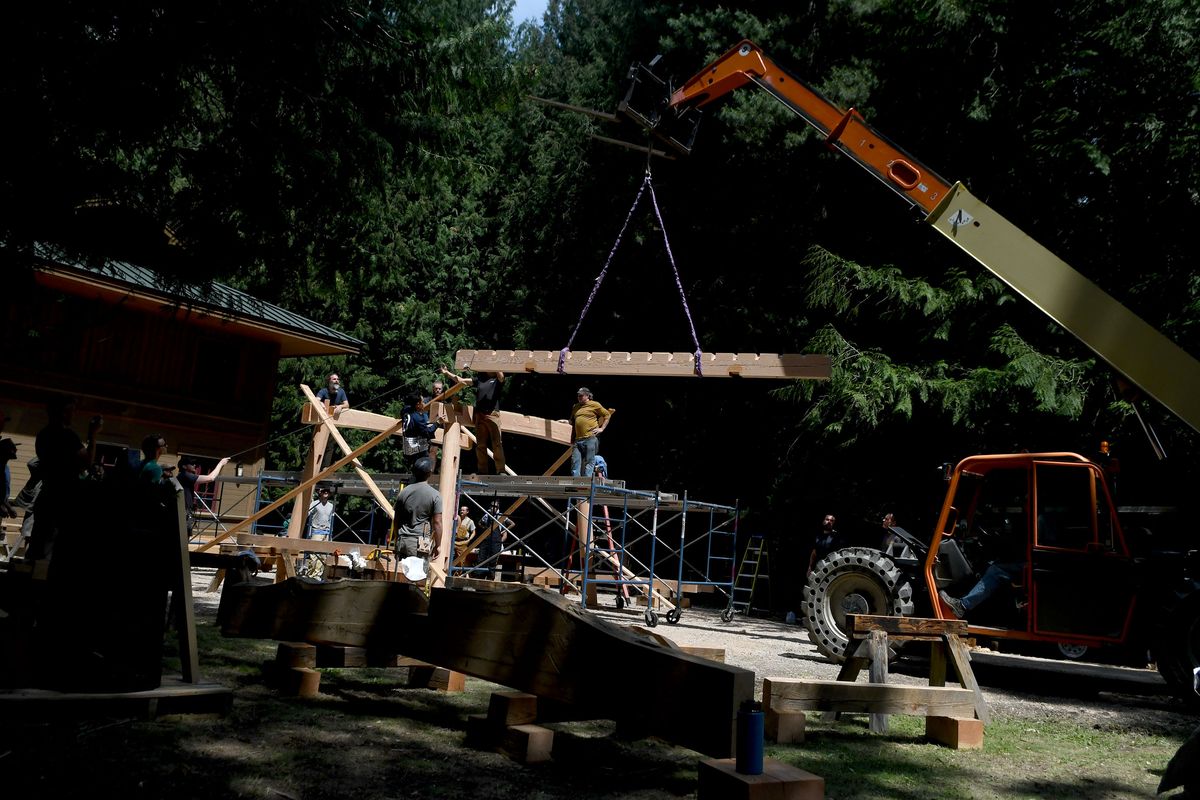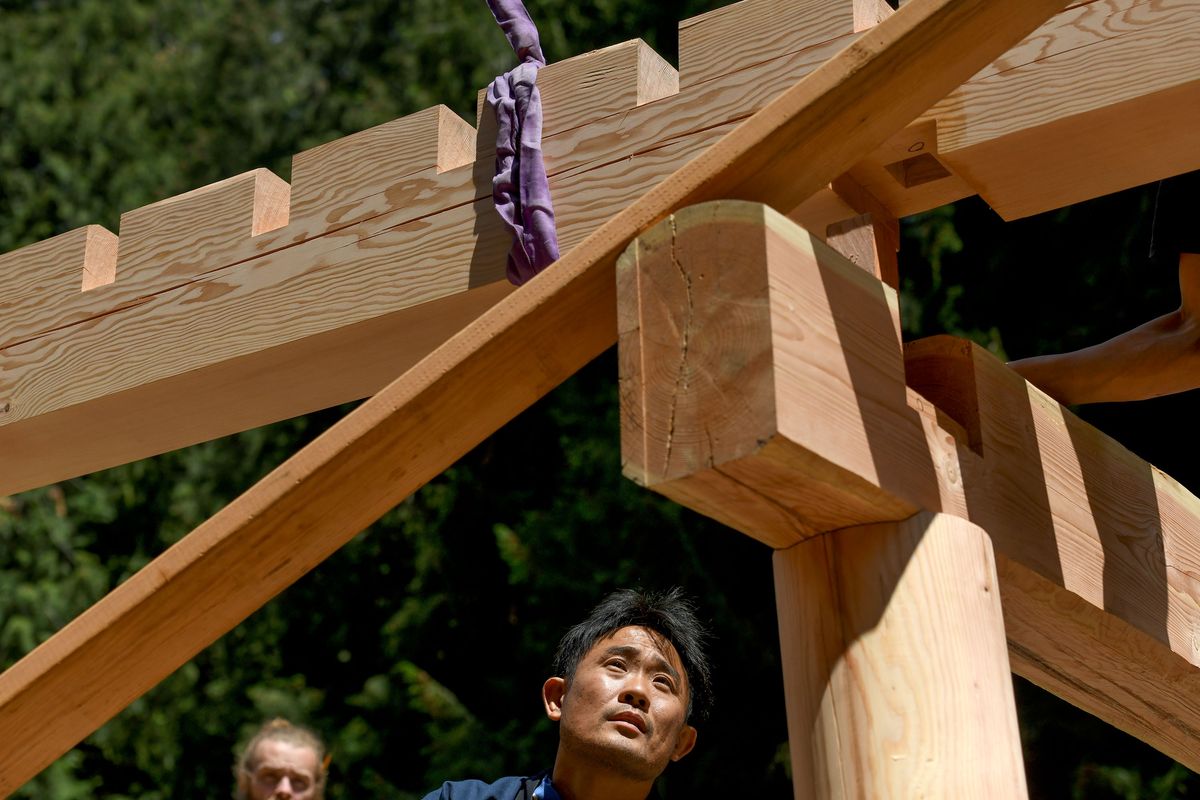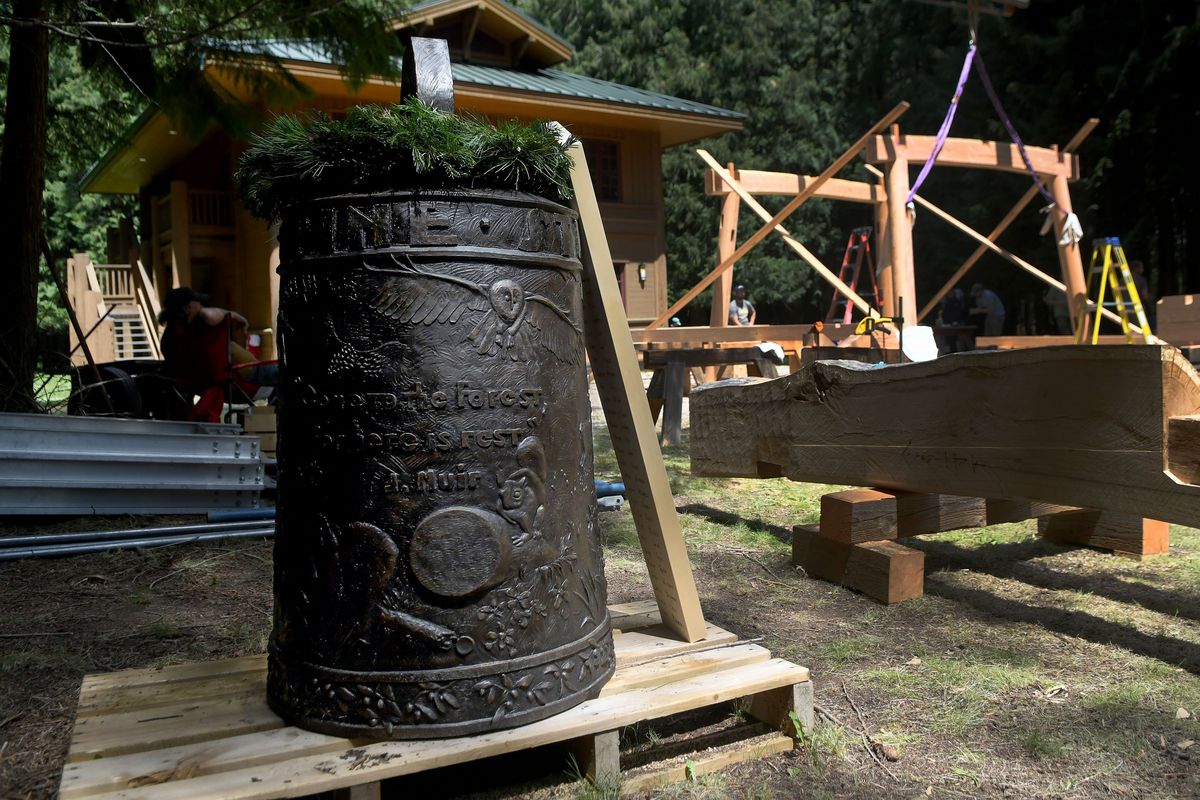Traditional timber framers, using Japanese and Indigenous methods, help raise belltower near Sandpoint

In the cool morning air, dappled sunlight filters through the boughs of towering cedars and onto the yard where two dozen carpenters are working. Huge logs are suspended, a warm fleshy hue to them as they are shaped in different stages. The foremost log still has the sharp edges of blade cutting. The middle log is losing these as tools scrape away geometric corners. The third is smooth and round, being sanded with the kind of care one might expect from a sculptor.
The forest is filled with the gentle knocking, thumping and humming of woodwork. These are not the power tools of a weekend project, but the sharpened blades and worn handles of tools made by timber framers. Occasionally, a grinder is heard as a blade is reshaped before it is plunged into, then drug across the tender meat of a log to peel away curls of wood. They fall to the ground in a silent pile and perfume the air with the rousing scent of fir.
Amid the workers, Kohei Yamamoto leans over a board taking measurements with a small triangle. Yamamoto, or Yama San as he is known to the carpenters here, wears a Patagonia pullover, his hair tied back loosely, and a perpetual expression of genuine curiosity and inquiry. His dark eyes settle with understanding as he resolves a calculation or an angle. As we speak, his hands fold together before him as if devoid of a tool to grasp, they need other engagement.
Yamamoto bears the humble titles of First Class Architect and First Class Carpenter. Trained in the traditional art of Japanese timber framing, he spent a decade apprenticing, first in the fine art of furniture-making and then timber framing. He learned how to restore shrines and temples, where bells have rung through mountains and villages for perhaps a thousand years or more.
Woodworkers from around the United States and Japanese timber framer Kohei Yamamoto, right, are building a beautiful wooden bell tower to house a new bell sculpted by artist Mark Kubiak in Sandpoint on Friday, June 16, 2023. (Kathy Plonka/The Spokesman-Review)Buy a print of this photo
It is then fitting that he finds himself now in the forests of North Idaho with a collection of students and international teachers, building a bell tower. As he talks about the deep relationship to the wood (a term used by each person with whom I spoke), he pauses and inquires if he might ask me a question. I oblige.
“But who will ring the bell? And what for?” Yamamoto San asked in his most delicate and wondering tone.
The history of the bell is a long one, tracing back millennia before Christ. Bells have been rung in celebration, in a calling toward, in mourning, in war and in warning. They have been hung from the necks of Bedouin goats and strung around the ankles of Indian dancers. They have been suspended in churches, clock towers, Shinto shrines and Buddhist temples. They have been rung in ritual and right of passage for eons.
The bell is an arguably integral component of community sound, because unlike most instruments, it is seldom for a private audience. Its sound comes from its shape, primarily, and the method of ringing. In shrines and temples, often a log is suspended by ropes to be gonged against the exterior of a bell. Other bells have “clappers,” or the part that hangs internally and bounces off the interior walls. The ringing of a bell (a remarkably thorough scientific study) has five parts that unify the unique sound of a bell, from its strike to the hum that follows as the sound waves bounce in predictable patterns inside.
While bells are typically tuned by shaving metal from the interior, this bell will not be tuned and, thus far, only one man knows its sound.
That man is Mark Kubiak, North Idaho artist and sculptor, and the person who conceived this bell in commemoration of the work of the Kaniksu Land Trust and its acquisition and creation of Pine Street Woods. For generations, the hundreds of forested acres of hills to the west of Sandpoint have been home to trails allowed by private land owners and the historic Pine Street Sled Hill. The land trust has collaborated with business, individual donors and granting organizations to raise $2.1 million to purchase and preserve the sled hill and surrounding acres for public use and conservation in perpetuity.
At Kubiak’s home in Dover, where the red-tailed hawks float in circles on the wind, the conception of the bell took shape. After nearly two years of research, sketches and clay sculpting, it was immortalized through a monthslong bronzing process. It required over a dozen separate pieces to be cast and shaped. For this is no smooth bell, but a complex and nuanced homage to nature, culture and community.
The bell, standing over 3 feet tall, is adorned with the flora and fauna of the Northwest. A ribbon of huckleberries skirts the bottom, a wren and fox pay tribute to local tribal mythology, cedar and pine trees stretch up the brown walls to the backdrop of mountains and sky. It is intricate, thoughtful, symbolic. A John Muir quote reminds us of the rest to be found in the forest, and around the top the words “pine street woods”complete a circle before the bell finishes with a star and sturdy loop from which it will hang.
But a bell needs a tower.
Katie Cox, the land trust’s executive director, is a different kind of visionary. In her small, blonde frame an effervescent energy bubbles forth. It is with this invitation to make art, to house the bell with an equally meaningful and magnificent structure, that she reached out to timber-framer Collin Beggs.
Beggs hones a deep respect for craftsmanship and a commitment to community demonstrated in his various forms of creative involvement. He is found on -site by seeking out the tallest hair and the least-protected feet, a westerner in a Japanese jinbei shirt (wrapped over the front and tied with a fabric ribbon), and eyes that smile and see everything at the same time. He connects and weaves ideas, qualities of wood, styles of framing, religion, myth, languages and stories of individuals all in the same answer to seemingly simple questions.
“A timber framer knows what you mean when you say ‘timber framer,’ ” Beggs said. “It basically means we don’t use metal fasteners.”
This is followed by an eloquent explanation of stylistic differences from fasteners to humble curves in the Japanese and American methods of timber framing.
The explanation includes a brief dive into Shintoism and nature, a moment of awe at Indigenous use of white pine bark and a note on the Kanji alphabet’s adaptation of Chinese characters.
One has the impression the conversation or answer could go anywhere, but it adeptly curves full circle back to work before us.
The project that is slowly being cut, carved, sanded, fit together, and raised, is the culmination of a collaboration between Beggs, the Timber Framers Guild and veteran framers, Kohei Yamamoto from Japan and Yann Giguère from Canada. Together with other local teachers, they are hosting a two-week timber framing workshop. Their project: the bell tower.
Four great posts are raised and fit together in tight joints, waxed generously so they can slide apart again (for the tower will be relocated once complete). Across the top are beams with carefully chiseled notches. A crane is used to hoist another as several carpenters communicate how to place the beam. In unison, they begin knocking the massive wood from both ends with large blocks as it slowly inches into place. There is a pleasant and open negotiation between the parties. A handful of students watch from below. Others are sanding smaller pieces of fir at workbenches. The hum and whir of building fills the yard.
Yann Giguère speaks with a heavy French Canadian accent. He stands with one woolen-socked foot on a large piece of Oregon oak. His boot is on the gravel next to him. He’s using an adze to work away uneven wood and shape the beam. Any bit of stone or sand between the blade and the wood will result in a need to sharpen the tool more frequently, and a raised mark on the timber. He seems less concerned about his foot.
Giguère’s beard and long hair are tied in knots as he describes the same almost spiritual connection to building through the craft of carpentry. The relationship, it seems, is mutual, interactive even. He talks of the patience of the skill, of how long the apprenticeship is, how often one begins merely by learning how to sharpen tools. It is not by accident that Beggs has invited these particular instructors to join him. They have decades of experience and the kind of calm fortitude one can only learn with time and trust.
“It’s not always the most accurate method,” Giguère said of the adze as he returns to knocking away at the wood in measured, even strokes, “but for me it is the most enjoyable.”
Among the group of students is Shawn Brigman, a member of the Spokane Tribe, and known for his building of traditional Salishan sturgeon-nose canoes from the bark of white pine. That tree, the state tree of Idaho, is dwindling in mature population for a number of reasons and heralded by timber framers. In conversation with Yamamoto, the two exchanged stories of the symbolism of nature.
The merging of this eclectic collection of cultures, crafts and region appears on the tower’s builder’s board, which leans against the waiting bell on a pallet. It will eventually be mounted like a plaque. Shintoism, Salish and the Pacific Northwest are woven together on the length of wood with the names of each teacher and student in precise ink lettering of Japanese style. On the other side, in Japanese Kanji characters, are the words “red-tailed hawk,” “red flicker” and “sturgeon.”
A red-tailed hawk had been seen circling above the building yard for several days.
As the tower takes shape in the yard, so too does the meaning of the bell. It is the testament to collaborative power of intersecting interests. When the project is completed in the coming months, the tower will be assembled upon a foundation near the top of the Pine Street Sled Hill, and the bell hung, then rung.
The bell will be rung at the first snow. It will be rung by children celebrating their summit of the sled hill, or their 30th lap. It will be rung by hikers and bikers, by families, by lone grievers who find solace in the resonant vibration, by cheering friends on a morning run, by someone commemorating the first spring trillium.
The bell will send its soft tones along the wind to the wings of the ted-tailed hawk, through the forest, and upon the distant ears of the people wandering there.
It will be the sound of a community bound by common earth and cause, and a shared reverence of nature.
Ammi Midstokke can be contacted at ammimarie@gmail.com.




